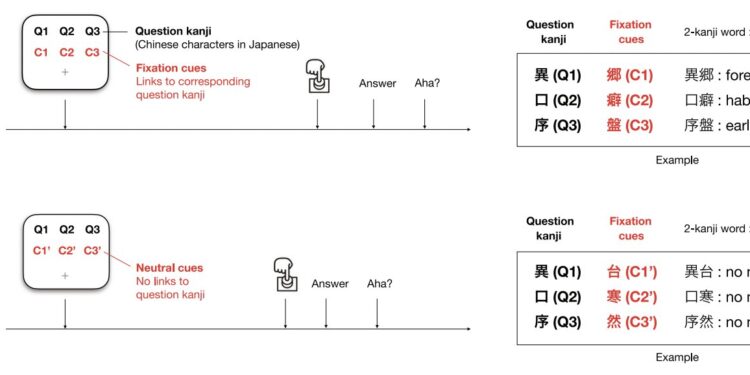Japanese FC-Rat. The sequence of events in a single test in the fixing condition (upper line) and the neutral condition (lower row). Under both conditions, participants receive a question and are invited to press a button once they have found an answer. After that, they provide their response; If it is correct, they will assess their AHA experience. Examples of the question and corresponding signals are indicated on the right. All questions and indices are listed in the additional table 1. The icon used in this figure has been obtained from Iconfinder (iconfinder.com/) and is available under a free license. Credit: Communications psychology (2025). DOI: 10.1038 / S44271-025-00235-4.
When humans try to grasp a complicated concept or solve a problem, they could suddenly have the impression of having acquired a deeper understanding or thinking about something that they had not thought before. This type of moments “AHA”, widely called “insight”, can play a key role in their ultimate capacity to acquire new precious knowledge or solve the problem at hand.
Many psychological studies have tried to paint a clearer image of the way in which the insight surfaces and the way it contributes to problem solving. While these studies have introduced various interesting theories, the dynamic process which leads to the emergence of insight remains poorly understood.
Researchers at the University of Tokyo have recently decided to explore this dynamic process using a combination of experimental methods and simulation tools. Their article, published in Communications psychologysuggests that insight is characterized by an exploration of broader distances in the space of possible solutions to a problem, ultimately offering more options for solving the problem.
“Insight represents a sudden and deep understanding, offering a new perspective which can offer the solution to a previously insoluble problem,” wrote Zenas C. Chao, Feng-Yang Hsieh and dog-tone Wu in their article. “Perspicacity is closely associated with an” AHA ”experience. Although various theories have tried to explain how the insight emerges, the dynamic research process leading to insight remains poorly understood, mainly due to the complex nature of creative problems.”
To study the information and the process fueling its emergence, the researchers carried out a series of experiences involving 105 participants. These participants were invited to perform a task which forced them to find a common association between three apparently unrelated logographic characters used in writing the Japanese language, also known as Kanji.
“In this study, we use two versions of the Japanese distance associate test (RAT) (n = 349 and n = 105 participants, respectively), parallel to a simulation model,” wrote Chao, Hsieh and Wu. “This allows us to quantitatively manipulate the constraints imposed on the problem and follow the research process in the solution.”
The researchers conducted two experimental tests, for which they used different variations in the task of combining rats. In the first experience, they checked the level of fixing of participants on the task and examined how it influenced their performance (that is to say their ability to discover associations between Kanji).
In this context, the term fixation refers to the undesirable emphasis on the same thoughts which are not useful for resolving the tests of rats association. On the other hand, the defixing involves putting aside these “incorrect thoughts” and exploring alternative possibilities, which can help solve a problem.
In the second experience, the researchers asked the participants to record each of their thoughts while they were trying to finish the task, just as happened. Finally, the researchers used a model to simulate how participants’ minds sailed in a corpus containing words in the Japanese language to resolve rat tasks.
“Our results indicate that the insight and the moment” AHA ”which accompanies it are characterized by an exploration which extends over greater distances in the space of the solution, thus increasing the number of potential solutions available for the evaluation”, wrote the researchers.
The results of this study have shed light on the creative thinking processes focused on information that contributes to the ability of people to solve problems, by exploring a wider range of possible solutions. In the future, the way Chao, Hsieh and Wu have framed the insight and the simulation model they used could inspire other similar experiences using other creative tasks or involving a greater number of participants, which could ultimately lead to new interesting observations.
More information:
Zenas C. Chao et al, long -distance exploration in perspicious problems solving, Communications psychology (2025). DOI: 10.1038 / S44271-025-00235-4.
© 2025 Science X Network
Quote: Understanding the moment “AHA”: the study suggests that insight consists in exploring greater distances in a solution space (2025, April 20) recovered on April 21, 2025
This document is subject to copyright. Apart from any fair program for private or research purposes, no part can be reproduced without written authorization. The content is provided only for information purposes.



